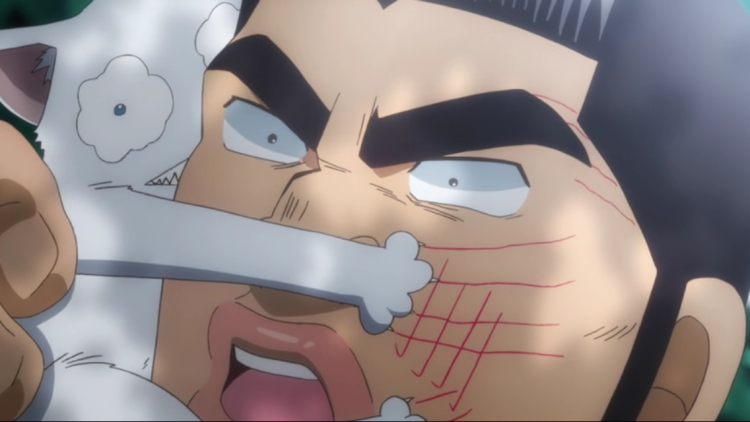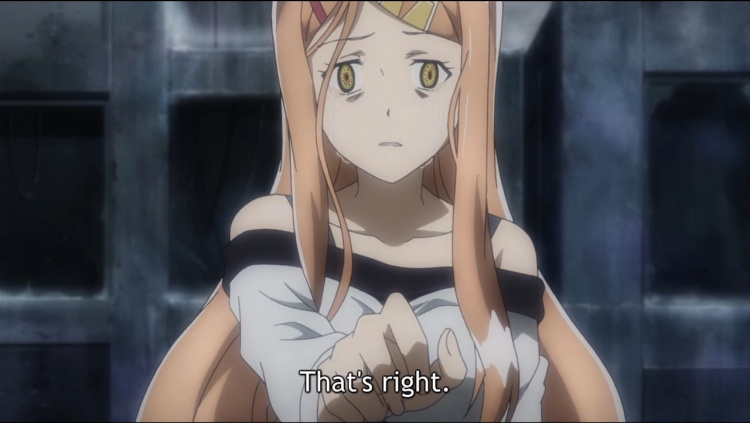I’m putting Plamemo on hold until it stops getting mired in rom-com shenanigans. Frankly, I need to put something on hold if I’m going to keep doing this, because I’ll be really busy over the next week or so. I’m heading to a film music conference in New York next weekend, to present a paper on Michiru Oshima’s score for Fullmetal Alchemist! I am really excited, but it means a lot of prep ahead of time. I am probably going to take Week 8 off to focus on my work and having fun at the conference. See you all then!
1. Blood Blockade Battlefront episode 7: I’d recently come to the conclusion on revisiting Trigun that music can do a lot to make up for a low budget and otherwise sloppy visuals. Well, Blood Blockade Battlefront delivers on those fronts, and yet its music still adds so much to each episode. I especially like that each episode has so much stylistic variety, and it still matches so well to every moment. Like this week, where we had operatic strains accompanying Leo meeting with Black and learning about White, and comparing her to his sister’s plight. (I’m not fully convinced White isn’t actually his sister on some level.) And then we had the hard rock for Zapp getting trapped and Klaus coming in to fight. There’s a lot to love about Blood Blockade Battlefront from week to week, and the soundtrack is no small part of that.
2. My Love Story!! episode 7: Full review here. This was probably the single cutest and most romantic episode of My Love Story!!, and that’s no small feat. Most episodes of this show are pretty adorable. This one did a lot to show you just how invested in each other Yamato and Takeo are. The answer: even more than you thought. I’m a little worried about how long My Love Story!! can run on this particular engine, but as for now I’m more than enjoying the ride.
3. Heroic Legend of Arslan episode 7: Full review here. This episode was a huge step up! It really fleshes out the Lusitanian side of the conflict, and gives us a bunch of new, fun characters and dynamics. I’m feeling good about where this show is going in a way I haven’t in weeks, and that’s awesome. Arslan has a ton of potential it needs to stop squandering.
4. Sound! Euphonium episode 7: This episode focused largely on the older students, showing how hard they’ve worked to keep the band alive when the previous seniors quit. Yet for some of them that isn’t enough to keep them in when the band starts interfering with their other dreams, like getting into a good university. This leads Aoi, tenor saxophonist and one of the leaders of the band, to quit. The band is finally the powerhouse she wanted it to be, but it also really doesn’t have room for her anymore if her sax isn’t going to be a priority. Sound! Euphonium in many ways is like the anti-K-ON!: it’s the real-world workings of a school music group, not the fantasy version that show serves up. It’s very refreshing, and the rich character interaction should make it work even for people who aren’t deep into the high school band world. We’ve all struggled with the trade-off between our goals and the things we do for fun. Some people take band as their top priority, like Asuka. For some people, it’s always going to be second fiddle, even if it’s still big enough to fight for it.
5. Jojo’s Bizarre Adventure: Stardust Crusaders episode 43: When was the last time Jojo’s was this straight-up dark? Vanilla Ice sure knows how to bring the terror. Polnareff is probably one of my favorite Stardust Crusaders, but he can be frustrating when you’re expected to take him seriously. Still, this was a strong, interesting battle, especially in watching him and Iggy put aside their differences to defeat such a formidable enemy. I kinda know how Stardust Crusaders ends, but I’m still a little worried for our Boston terrier there. Vanilla Ice and his stand Cream are a terrifying pair, and he and Polnareff are pretty stuck. This is Jojo’s, though, so I’m sure they’ll get it out of in some bonkers way with a rocking soundtrack.
6. Sailor Moon Crystal episode 22: I can’t believe it, but I think this week Crystal was actually kind of good? The plot was easy to follow and the characters had personality (Venus even expressed regret that she’s so powerless during this arc). Usagi actually cared about her friends as much as her boyfriend. I could actually feel for the villains as they got frustrated over their Prince Demande going insane. And Black Lady is already a menacing, mysterious presence. I also think the show saved pretty much all its art and animation budget for this episode, as there was a noticeable lack of mistakes and upgrade in the visual quality. I especially liked the design for Wiseman, Neo-Queen Serenity and the other non-physical “projections,” with textures that reminded me of the character designs in Gankutsuou. Not a comparison I ever thought I’d be making for this show! I hope Sailor Moon Crystal can keep up this level of quality in the last few episodes. I might actually be pumped to watch them now.
7. Fate/stay night: Unlimited Blade Works episode 19: This episode falls into one of the franchise’s major weaknesses: excessive talking that doesn’t translate well to film. I wasn’t as negative on this episode as Gabbo was—in fact, I mostly enjoyed it, apart from the creepy Shinji stuff—but it does make it clear how much they’re stalling for time. Now that we’re coming down the wire to our true, final antagonists in the form of KK and Gilgamesh, I’m not sure how this show expects to fill its remaining episodes. I surely hope it’s not all with Archer monologues.
8. Wish Upon the Pleiades episode 7: Full review here. Well, that sure wasn’t promising. Wish Upon the Pleiades gave itself a tall order last week, but one it could at least take some steps toward delivering. And it…didn’t even try. With the exception of a few moments hinting that something is seriously wrong with Minato, it was all meaningless friendship hijinks. Oh well. Better luck next time? Maybe? I don’t really know what to expect from this show anymore. I’m not sure if it even wants to try.















